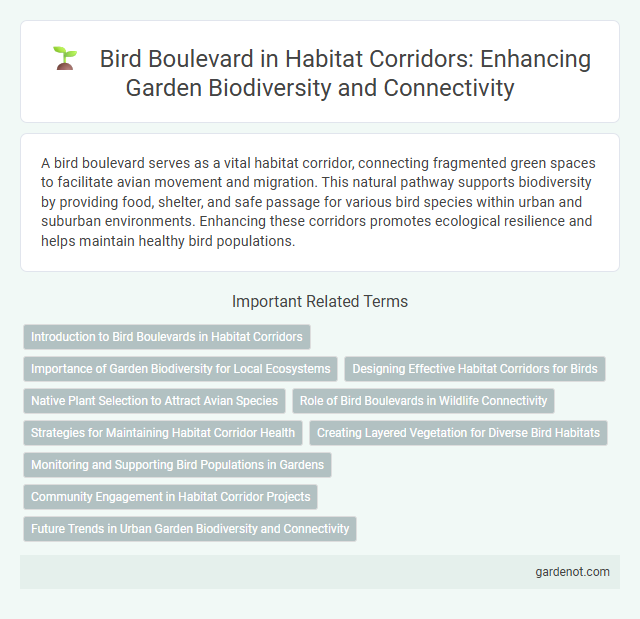A bird boulevard serves as a vital habitat corridor, connecting fragmented green spaces to facilitate avian movement and migration. This natural pathway supports biodiversity by providing food, shelter, and safe passage for various bird species within urban and suburban environments. Enhancing these corridors promotes ecological resilience and helps maintain healthy bird populations.
Introduction to Bird Boulevards in Habitat Corridors
Bird Boulevards are designed as specialized habitat corridors that facilitate safe avian movement across fragmented landscapes, enhancing biodiversity and ecosystem connectivity. These corridors integrate native vegetation, nesting sites, and food resources to support migratory and local bird populations. Strategic placement along urban and rural greenways reduces habitat isolation, promoting genetic diversity and long-term species survival.
Importance of Garden Biodiversity for Local Ecosystems
Garden biodiversity plays a critical role in supporting local ecosystems by providing essential habitats and food sources for various bird species along the Bird Boulevard. Diverse plant species attract pollinators, insects, and seeds that sustain the diet of birds while promoting natural pest control. Enhancing garden biodiversity in urban corridors contributes to healthier bird populations and strengthens ecological connectivity.
Designing Effective Habitat Corridors for Birds
Designing effective habitat corridors for birds, such as Bird Boulevard, involves creating continuous, vegetated pathways that connect fragmented habitats and facilitate safe migration and foraging. Incorporating native plant species and varying canopy heights enhances shelter and food availability, promoting biodiversity and supporting multiple bird species throughout their life cycles. Monitoring corridor usage through bird banding and acoustic surveys guides adaptive management to optimize habitat quality and connectivity.
Native Plant Selection to Attract Avian Species
Native plant selection on Bird Boulevard is strategically focused on attracting a diverse range of avian species by providing essential food sources, shelter, and nesting sites. Key native plants such as flowering dogwood, elderberry, and wild cherry offer berries and nectar that sustain local bird populations throughout the seasons. Incorporating these indigenous plants enhances habitat connectivity and promotes biodiversity within the habitat corridor.
Role of Bird Boulevards in Wildlife Connectivity
Bird Boulevards serve as vital habitat corridors that enhance wildlife connectivity by linking fragmented ecosystems and enabling safe movement for bird species. These green pathways support migratory routes and genetic diversity by providing continuous vegetation cover and nesting sites across urban and suburban areas. Implementing Bird Boulevards helps mitigate habitat isolation, promoting biodiversity and resilience in avian populations.
Strategies for Maintaining Habitat Corridor Health
Bird Boulevard employs targeted strategies for maintaining habitat corridor health, including native vegetation restoration to enhance food and shelter resources for migratory species. Regular monitoring of bird populations and habitat quality allows for early detection of ecological disturbances and informs adaptive management practices. Implementing buffer zones minimizes urban encroachment, reducing habitat fragmentation and preserving continuous corridors essential for avian biodiversity.
Creating Layered Vegetation for Diverse Bird Habitats
Creating layered vegetation in Bird Boulevard enhances habitat complexity by providing distinct canopy, shrub, and ground layers essential for diverse bird species. This stratified plant structure supports various feeding, nesting, and sheltering needs, promoting biodiversity and ecological resilience. Integrating native trees, shrubs, and groundcovers nurtures microhabitats critical for migratory and resident birds within the habitat corridor.
Monitoring and Supporting Bird Populations in Gardens
Bird Boulevard promotes effective monitoring and support of bird populations by integrating smart sensors and citizen science initiatives in residential gardens. Real-time data collection on bird species diversity and behavior enables targeted conservation strategies and habitat enhancements. Community engagement through educational programs improves awareness, fostering sustainable practices that bolster local avian biodiversity.
Community Engagement in Habitat Corridor Projects
Bird Boulevard serves as a model for community engagement in habitat corridor projects, actively involving local residents and stakeholders in conservation planning and implementation. This collaboration fosters environmental stewardship, enhances biodiversity by connecting fragmented habitats, and promotes educational outreach on the importance of urban wildlife corridors. Such grassroots participation ensures sustainable habitat restoration, supporting native bird populations and reinforcing ecosystem resilience.
Future Trends in Urban Garden Biodiversity and Connectivity
Bird Boulevard exemplifies future trends in urban garden biodiversity and connectivity by integrating native plant species to enhance habitat corridors for avian populations. This innovative design prioritizes ecological networks that facilitate bird movement and genetic exchange, promoting urban wildlife resilience. Incorporating smart irrigation and sensor technologies ensures sustainable maintenance while supporting diverse ecosystems within densely populated cityscapes.
Bird boulevard Infographic

 gardenot.com
gardenot.com